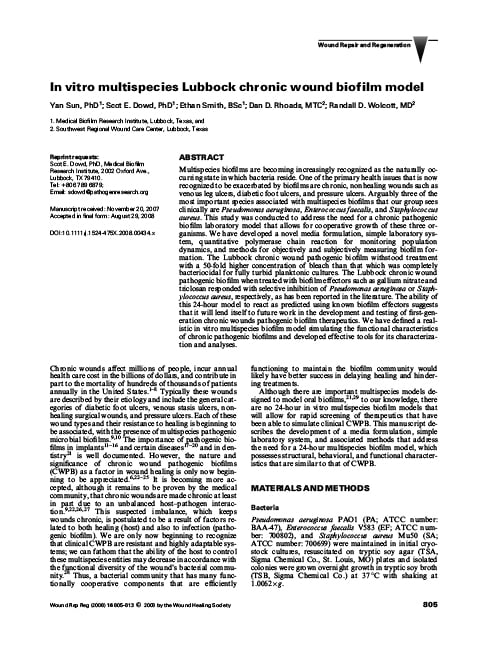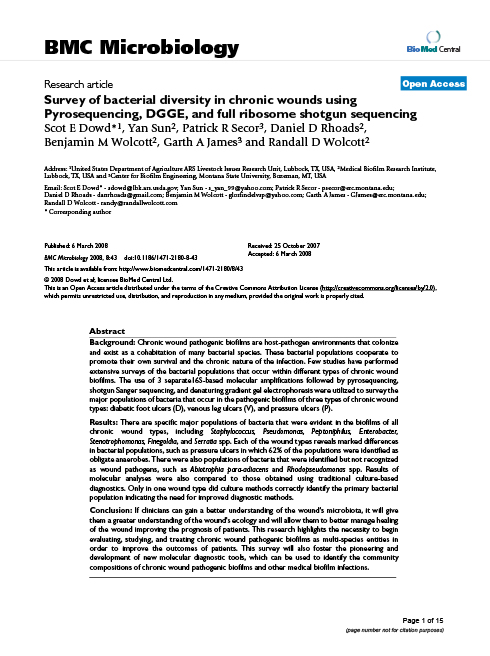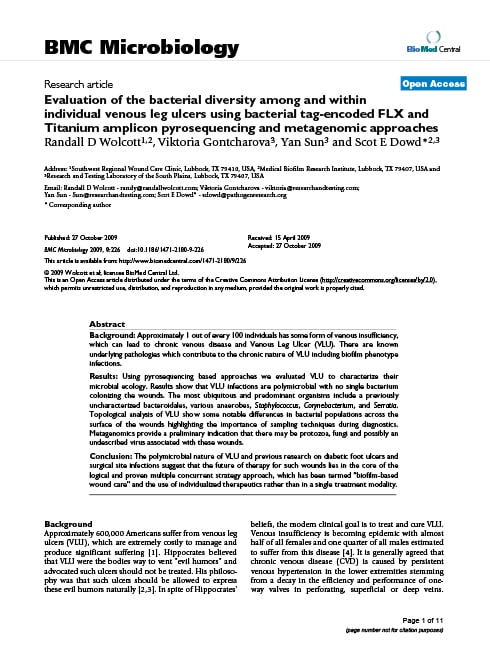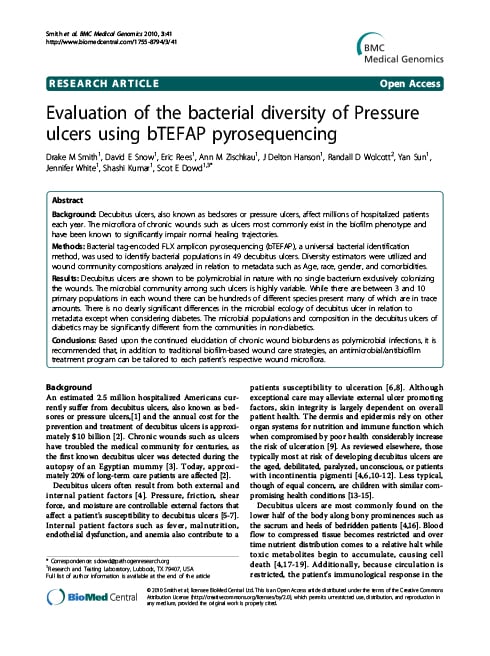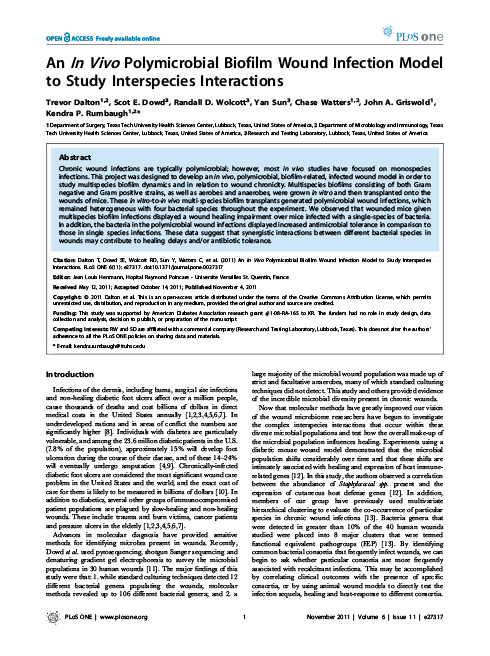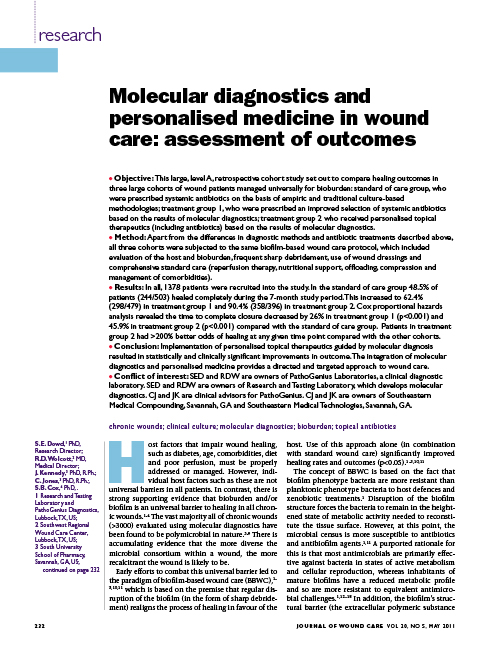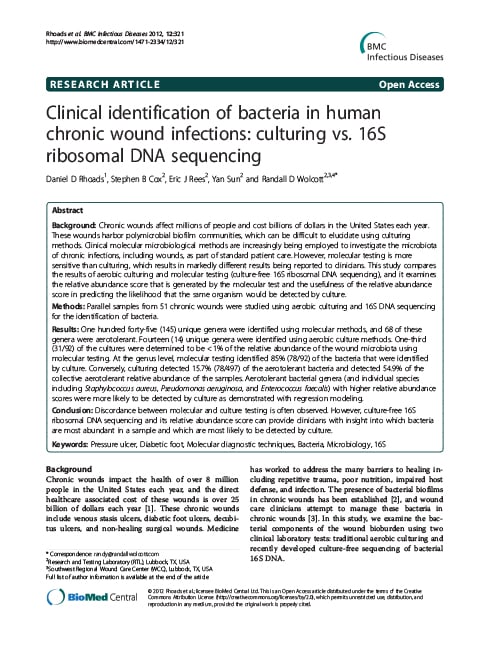- Wound Repair and Regeneration. 2008;16(6):805-813. Research: The study addresses the need for a chronic pathogenic biofilm laboratory model that allows for cooperative growth of three commonly seen organisms: Pseudomonas aeruginosa, Enterococcus faecalis, and Staphylococcus aureus. The study developed a novel media formulation, simple laboratory system, quantitative polymerase chain reaction for monitoring population dynamics, and methods for objectively and subjectively measuring biofilm formation. The 24‐hour model reacts as predicted using known biofilm effectors, lending itself to future work in the development and testing of first‐generation chronic wounds pathogenic biofilm therapeutics.
- BMC Microbiology. 2008;8:43-58. Research Article: A survey was conducted of major bacterial populations which occur in the pathogenic biofilms of three chronic wound types: diabetic foot ulcers (D), venous leg ulcers (V), and pressure ulcers (P). The study used 3 separate 16S-based molecular amplifications followed by pyrosequencing, shotgun Sanger sequencing, and denaturing gradient gel electrophoresis. The survey study revealed that a wide variety of bacteria with different physiological and phenotypic preferences are common as part of pathogenic biofilm communities in chronic wounds. However, different types of wounds may have different bacterial populations that are prevalent, such as pressure ulcers in […]
- BMC Microbiology. 2009;9:226-237. Research Article: A pyrosequencing approach was used to characterize the microbial ecology of 40 venous leg ulcer (VLU) samples. Results show that VLU infections are polymicrobial with no single bacterium colonizing the wounds. The most ubiquitous and predominant organisms include previously uncharacterized bacteroidales, various anaerobes, Staphylococcus, Corynebacterium, and Serratia. Topological analysis of VLU show some notable differences in bacterial populations across the surface of the wounds, highlighting the importance of sampling techniques during diagnostics. Metagenomics provide a preliminary indication that there may be protozoa, fungi and possibly an undescribed virus associated with these wounds.
- BMC Medical Genomics. 2010;3:41-52. Research Article: Bacterial tag-encoded FLX amplicon pyrosequencing was used to identify the bacterial populations in 49 decubitus ulcers. Decubitus ulcers are shown to be polymicrobial, highly variable (228 genera identified among 49 ulcers) microbial communities dominated by 3 to 10 microorganisms, with obligate anaerobes found in significant proportion. In the decubitus ulcers of diabetics the microbial populations and composition may be significantly different from the communities in non-diabetics. The highly unique profile of each individual wound would require a therapeutic approach tailored to the patient’s respective wound microflora and traditional culture is largely inadequate in determining […]
- J Wound Care. 2010;19(7):272-281. Study: The study compares healing rates and healing time of two cohorts, one before implementation of molecular diagnostics, one after. Each cohort consisted of ~500 patients with various wound types. The introduction of molecular pathogen diagnostics, with a corresponding precise and targeted therapeutic approach, improved healing rates from 48.5% to 62.4% and reduced healing time by 20% across wound types.
- PLoS One. 2011;6(11):e27317. Research Article: Multispecies biofilms consisting of both Gram negative and Gram positive strains, as well as aerobes and anaerobes, were grown in vitro and then transplanted onto the wounds of mice. Wounded mice given multispecies biofilm infections displayed a wound healing impairment over mice infected with a single-species of bacteria. In addition, the bacteria in the polymicrobial wound infections displayed increased antimicrobial tolerance in comparison to those in single species infections. These data suggest that synergistic interactions between different bacterial species in wounds may contribute to healing delays and/or antibiotic tolerance.
- J Wound Care. 2011;20(5):232-239. Retrospective Study: This level A, retrospective cohort study compared healing outcomes in three large cohorts (400-500 patients each) of wound patients managed universally for bioburden: standard of care group, who were prescribed systemic antibiotics on the basis of empiric and traditional culture-based methodologies; treatment group 1, who were prescribed an improved selection of systemic antibiotics based on the results of molecular diagnostics; treatment group 2 who received personalized topical therapeutics (including antibiotics) based on the results of molecular diagnostics. In comparison to the standard of care group, healing rates improved from 48.5% to 62.4% in treatment […]
- BMC Infect Dis. 2012;12:321-329 Comparative Study: Parallel samples from 51 chronic wounds were studied using aerobic culturing and 16S DNA sequencing for the identification of bacteria. Compared to 16S DNA sequencing, aerobic culture detected only half of the bacteria determined to comprise a dominant portion of the microbiota. At the genus level, molecular testing identified 85% (78/92) of the bacteria identified by culture. Conversely, culturing detected 15.7% (78/497) of the aerotolerant bacteria and detected 54.9% of the collective aerotolerant relative abundance of the samples. Read Study…
MicroGenDX office and laboratory will be closed for Christmas (12/25/25). Normal office hours will resume 12/26/25.
